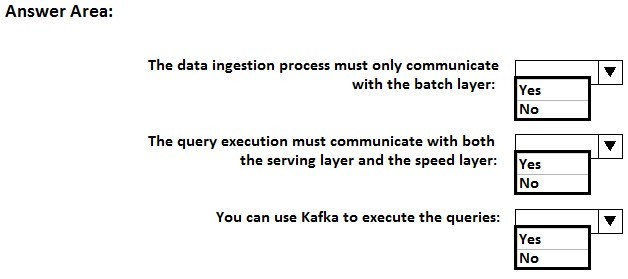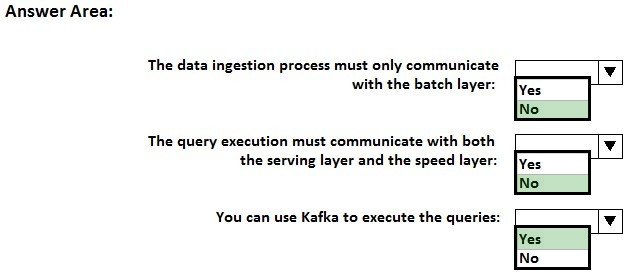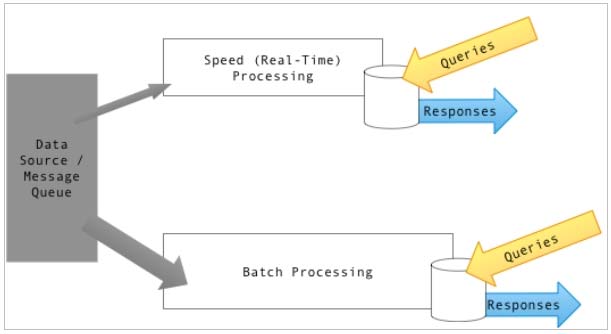Microsoft 70-475 Exam Practice Questions (P. 2)
- Full Access (42 questions)
- Six months of Premium Access
- Access to one million comments
- Seamless ChatGPT Integration
- Ability to download PDF files
- Anki Flashcard files for revision
- No Captcha & No AdSense
- Advanced Exam Configuration
Question #6
Note: The question is part of a series of questions that present the same scenario. Each question in the series contains a unique solution that might meet the stated goals. Some question sets might have more than one correct solution, while others might not have a correct solution.
After you answer a question in this section, you will NOT be able to return to it. As a result, these questions will not appear in the review screen.
Your company has multiple databases that contain millions of sales transactions.
You plan to implement a data mining solution to identify purchasing fraud.
You need to design a solution that mines 10 terabytes (TB) of sales date. The solution must meet the following requirements:
✑ Run the analysis to identify fraud once per week.
✑ Continue to receive new sales transactions while the analysis runs.
✑ Be able to stop computing services when the analysis is NOT running.
Solution: You create a Cloudera Hadoop cluster on Microsoft Azure virtual machines.
Does this meet the goal?
After you answer a question in this section, you will NOT be able to return to it. As a result, these questions will not appear in the review screen.
Your company has multiple databases that contain millions of sales transactions.
You plan to implement a data mining solution to identify purchasing fraud.
You need to design a solution that mines 10 terabytes (TB) of sales date. The solution must meet the following requirements:
✑ Run the analysis to identify fraud once per week.
✑ Continue to receive new sales transactions while the analysis runs.
✑ Be able to stop computing services when the analysis is NOT running.
Solution: You create a Cloudera Hadoop cluster on Microsoft Azure virtual machines.
Does this meet the goal?
- AYes
- BNo
Correct Answer:
A
Processing large amounts of unstructured data requires serious computing power and also maintenance effort. As load on computing power typically fluctuates due to time and seasonal influences and/or processes running on certain times, a cloud solution like Microsoft Azure is a good option to be able to scale up easily and pay only for what is actually used.
Reference: http://blog.cloudera.com/blog/2016/02/how-to-install-cloudera-enterprise-on-microsoft-azure-part-1/
A
Processing large amounts of unstructured data requires serious computing power and also maintenance effort. As load on computing power typically fluctuates due to time and seasonal influences and/or processes running on certain times, a cloud solution like Microsoft Azure is a good option to be able to scale up easily and pay only for what is actually used.
Reference: http://blog.cloudera.com/blog/2016/02/how-to-install-cloudera-enterprise-on-microsoft-azure-part-1/
send
light_mode
delete
Question #7
Note: The question is part of a series of questions that present the same scenario. Each question in the series contains a unique solution that might meet the stated goals. Some question sets might have more than one correct solution, while others might not have a correct solution.
After you answer a question in this section, you will NOT be able to return to it. As a result, these questions will not appear in the review screen.
Your company has multiple databases that contain millions of sales transactions.
You plan to implement a data mining solution to identify purchasing fraud.
You need to design a solution that mines 10 terabytes (TB) of sales date. The solution must meet the following requirements:
✑ Run the analysis to identify fraud once per week.
✑ Continue to receive new sales transactions while the analysis runs.
✑ Be able to stop computing services when the analysis is NOT running.
Solution: You create a Microsoft Azure Data Lake job.
Does this meet the goal?
After you answer a question in this section, you will NOT be able to return to it. As a result, these questions will not appear in the review screen.
Your company has multiple databases that contain millions of sales transactions.
You plan to implement a data mining solution to identify purchasing fraud.
You need to design a solution that mines 10 terabytes (TB) of sales date. The solution must meet the following requirements:
✑ Run the analysis to identify fraud once per week.
✑ Continue to receive new sales transactions while the analysis runs.
✑ Be able to stop computing services when the analysis is NOT running.
Solution: You create a Microsoft Azure Data Lake job.
Does this meet the goal?
send
light_mode
delete
Question #8
Note: The question is part of a series of questions that present the same scenario. Each question in the series contains a unique solution that might meet the stated goals. Some question sets might have more than one correct solution, while others might not have a correct solution.
After you answer a question in this section, you will NOT be able to return to it. As a result, these questions will not appear in the review screen.
Your company has multiple databases that contain millions of sales transactions.
You plan to implement a data mining solution to identify purchasing fraud.
You need to design a solution that mines 10 terabytes (TB) of sales date. The solution must meet the following requirements:
✑ Run the analysis to identify fraud once per week.
✑ Continue to receive new sales transactions while the analysis runs.
✑ Be able to stop computing services when the analysis is NOT running.
Solution: You create a Microsoft Azure HDInsight cluster.
Does this meet the goal?
After you answer a question in this section, you will NOT be able to return to it. As a result, these questions will not appear in the review screen.
Your company has multiple databases that contain millions of sales transactions.
You plan to implement a data mining solution to identify purchasing fraud.
You need to design a solution that mines 10 terabytes (TB) of sales date. The solution must meet the following requirements:
✑ Run the analysis to identify fraud once per week.
✑ Continue to receive new sales transactions while the analysis runs.
✑ Be able to stop computing services when the analysis is NOT running.
Solution: You create a Microsoft Azure HDInsight cluster.
Does this meet the goal?
- AYes
- BNo
Correct Answer:
B
HDInsight cluster billing starts once a cluster is created and stops when the cluster is deleted. Billing is pro-rated per minute, so you should always delete your cluster when it is no longer in use.
Reference: https://docs.microsoft.com/en-us/azure/hdinsight/hdinsight-hadoop-provision-linux-clusters
B
HDInsight cluster billing starts once a cluster is created and stops when the cluster is deleted. Billing is pro-rated per minute, so you should always delete your cluster when it is no longer in use.
Reference: https://docs.microsoft.com/en-us/azure/hdinsight/hdinsight-hadoop-provision-linux-clusters
send
light_mode
delete
Question #9
HOTSPOT -
You are designing a solution based on the lambda architecture.
The solution has the following layers:
✑ Batch
✑ Speed
✑ Serving
You are planning the data ingestion process and the query execution.
For each of the following statements, select Yes if the statement is true. Otherwise, select No.
NOTE: Each correct selection is worth one point.
Hot Area:

You are designing a solution based on the lambda architecture.
The solution has the following layers:
✑ Batch
✑ Speed
✑ Serving
You are planning the data ingestion process and the query execution.
For each of the following statements, select Yes if the statement is true. Otherwise, select No.
NOTE: Each correct selection is worth one point.
Hot Area:

Correct Answer:

Box 1: No -
Box 2: No -
Output from the batch and speed layers are stored in the serving layer, which responds to ad-hoc queries by returning precomputed views or building views from the processed data.

Box 3: Yes.
We are excited to announce Interactive Queries, a new feature for stream processing with Apache Kafka. Interactive Queries allows you to get more than just processing from streaming.
Note: Lambda architecture is a popular choice where you see stream data pipelines applied (speed layer). Architects can combine Apache Kafka or Azure Event
Hubs (ingest) with Apache Storm (event processing), Apache HBase (speed layer), Hadoop for storing the master dataset (batch layer), and, finally, Microsoft
Power BI for reporting and visualization (serving layer).
Reference: https://www.confluent.io/blog/unifying-stream-processing-and-interactive-queries-in-apache-kafka/ https://en.wikipedia.org/wiki/Lambda_architecture

Box 1: No -
Box 2: No -
Output from the batch and speed layers are stored in the serving layer, which responds to ad-hoc queries by returning precomputed views or building views from the processed data.

Box 3: Yes.
We are excited to announce Interactive Queries, a new feature for stream processing with Apache Kafka. Interactive Queries allows you to get more than just processing from streaming.
Note: Lambda architecture is a popular choice where you see stream data pipelines applied (speed layer). Architects can combine Apache Kafka or Azure Event
Hubs (ingest) with Apache Storm (event processing), Apache HBase (speed layer), Hadoop for storing the master dataset (batch layer), and, finally, Microsoft
Power BI for reporting and visualization (serving layer).
Reference: https://www.confluent.io/blog/unifying-stream-processing-and-interactive-queries-in-apache-kafka/ https://en.wikipedia.org/wiki/Lambda_architecture
send
light_mode
delete
Question #10
DRAG DROP -
You have a web app that accepts user input, and then uses a Microsoft Azure Machine Learning model to predict a characteristic of the user.
You need to perform the following operations:
✑ Track the number of web app users from month to month.
✑ Track the number of successful predictions made during the last minute.
✑ Create a dashboard showcasing the analytics for the predictions and the web app usage.
Which lambda layer should you query for each operation? To answer, drag the appropriate layers to the correct operations. Each layer may be used once, more than once, or not at all. You may need to drag the split bar between panes or scroll to view content.
NOTE: Each correct selection is worth one point.
Select and Place:

You have a web app that accepts user input, and then uses a Microsoft Azure Machine Learning model to predict a characteristic of the user.
You need to perform the following operations:
✑ Track the number of web app users from month to month.
✑ Track the number of successful predictions made during the last minute.
✑ Create a dashboard showcasing the analytics for the predictions and the web app usage.
Which lambda layer should you query for each operation? To answer, drag the appropriate layers to the correct operations. Each layer may be used once, more than once, or not at all. You may need to drag the split bar between panes or scroll to view content.
NOTE: Each correct selection is worth one point.
Select and Place:

Correct Answer:

Lambda architecture is a data-processing architecture designed to handle massive quantities of data by taking advantage of both batch- and stream-processing methods. This approach to architecture attempts to balance latency, throughput, and fault-tolerance by using batch processing to provide comprehensive and accurate views of batch data, while simultaneously using real-time stream processing to provide views of online data. The two view outputs may be joined before presentation
Box 1: Speed -
The speed layer processes data streams in real time and without the requirements of fix-ups or completeness. This layer sacrifices throughput as it aims to minimize latency by providing real-time views into the most recent data.
Box 2: Batch -
The batch layer precomputes results using a distributed processing system that can handle very large quantities of data. The batch layer aims at perfect accuracy by being able to process all available data when generating views.
Box 3: Serving -
Output from the batch and speed layers are stored in the serving layer, which responds to ad-hoc queries by returning precomputed views or building views from the processed data.
Reference: https://en.wikipedia.org/wiki/Lambda_architecture

Lambda architecture is a data-processing architecture designed to handle massive quantities of data by taking advantage of both batch- and stream-processing methods. This approach to architecture attempts to balance latency, throughput, and fault-tolerance by using batch processing to provide comprehensive and accurate views of batch data, while simultaneously using real-time stream processing to provide views of online data. The two view outputs may be joined before presentation
Box 1: Speed -
The speed layer processes data streams in real time and without the requirements of fix-ups or completeness. This layer sacrifices throughput as it aims to minimize latency by providing real-time views into the most recent data.
Box 2: Batch -
The batch layer precomputes results using a distributed processing system that can handle very large quantities of data. The batch layer aims at perfect accuracy by being able to process all available data when generating views.
Box 3: Serving -
Output from the batch and speed layers are stored in the serving layer, which responds to ad-hoc queries by returning precomputed views or building views from the processed data.
Reference: https://en.wikipedia.org/wiki/Lambda_architecture
send
light_mode
delete
All Pages
